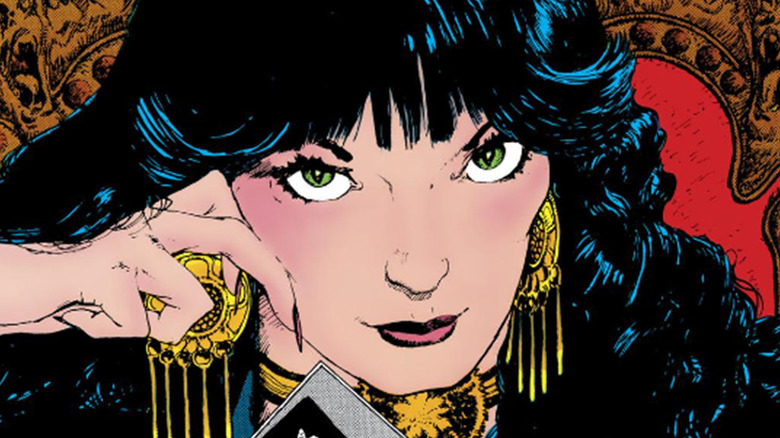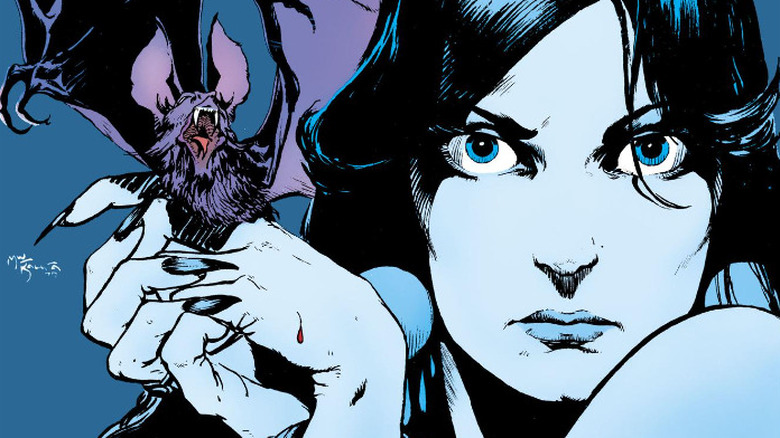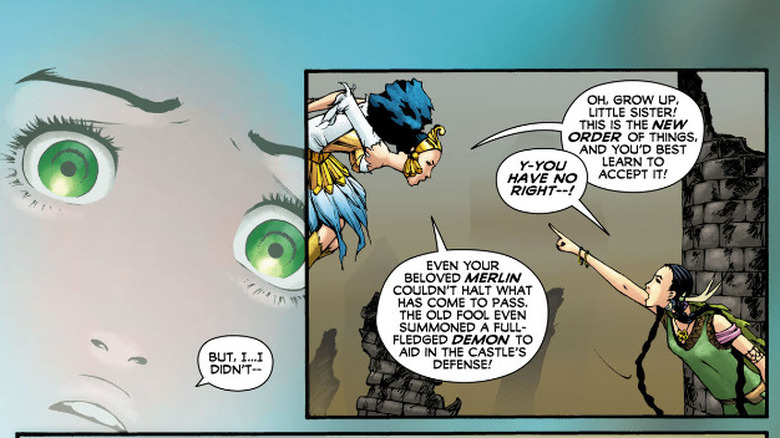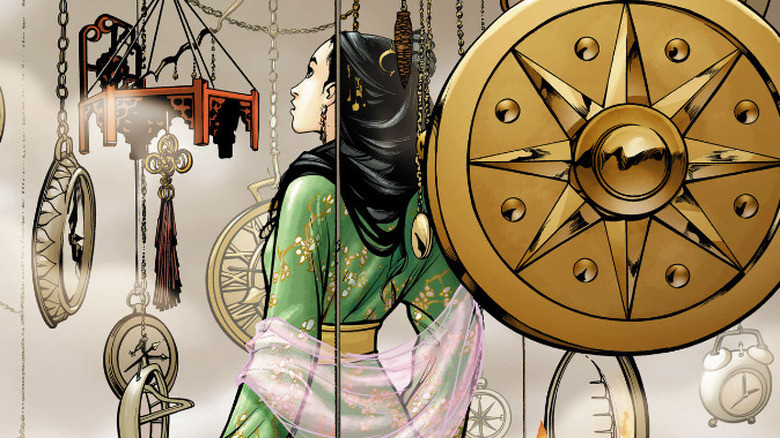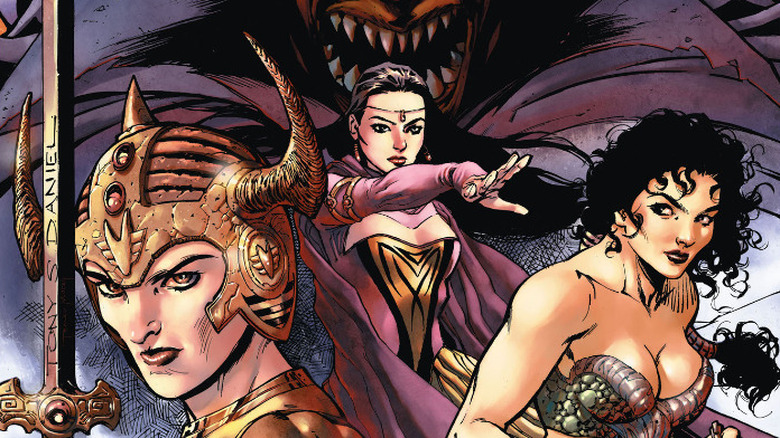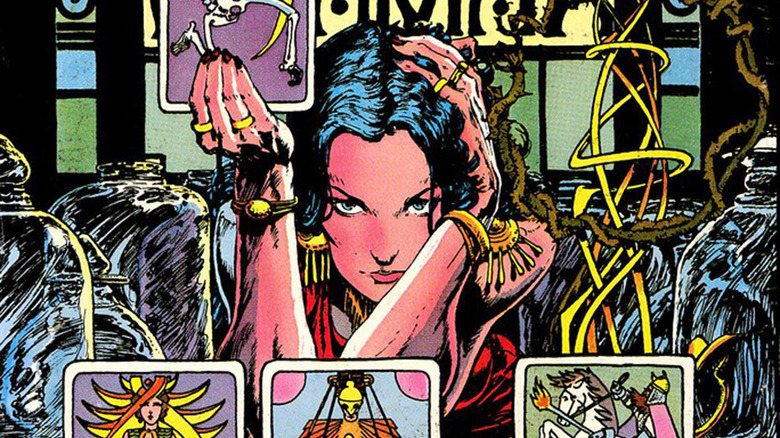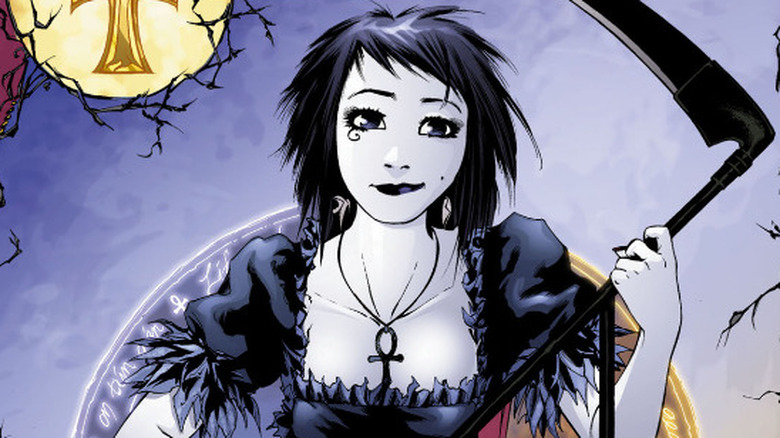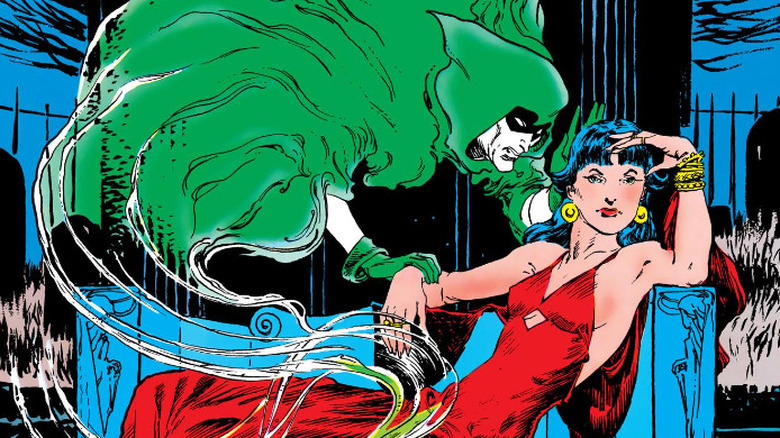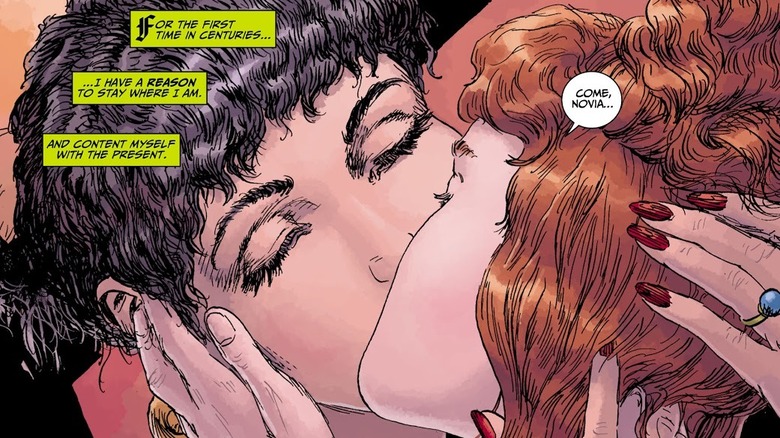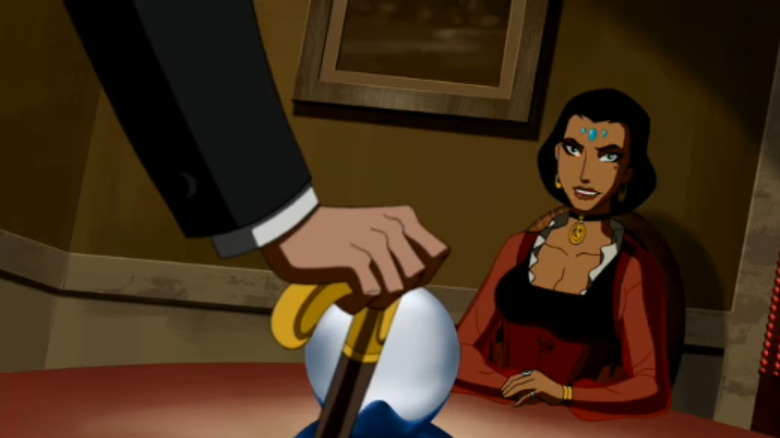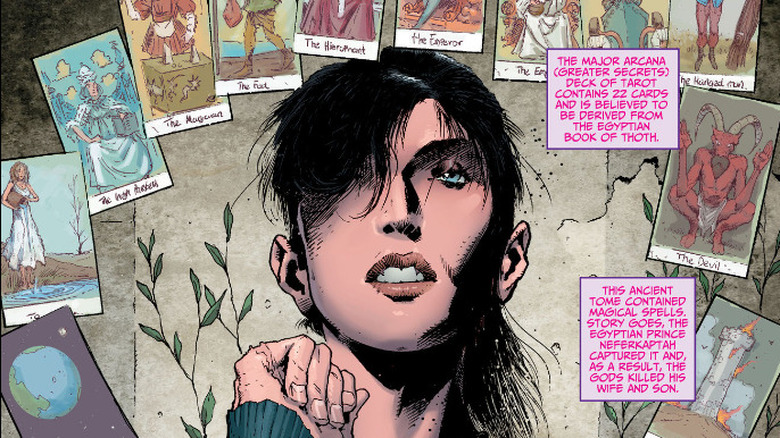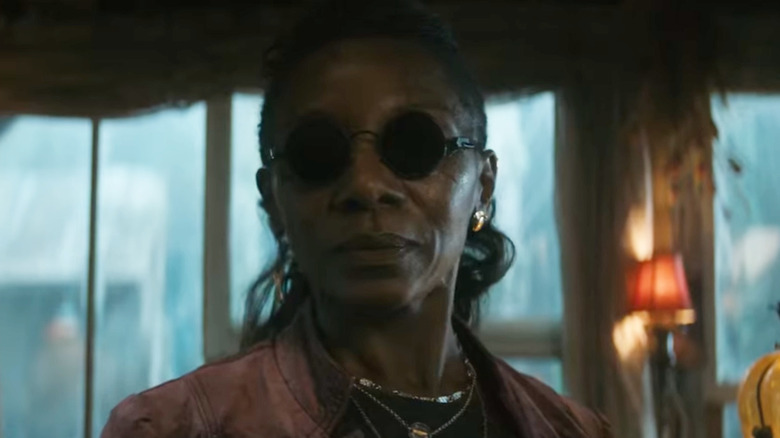The Untold Truth Of DC's Madame X
Take a walk down a quiet street of New York's East Village and you may notice an unassuming door. There is a sign beside it, enticing passersby into entering Madame Xanadu's occult shop "freely and unafraid." Or was it a street in Greenwich Village? New Orleans, perhaps? It doesn't matter. The details may shift like the cards in a tarot reading, but the truth emerges. For more than four decades, Madame X has been a magical cornerstone of DC Comics, operating from shadows so thick, many don't even know she exists. Sorceress, fortune teller, occult advisor — Madame Xanadu has been many things in her long life. But until HBO announced that she's getting her own series, entitled "Madame X," "television star" was not one of them.
An unusual choice? Maybe. But Madame X is an unusual woman. With an expansive history that's largely untapped, full of ties to countless corners of the DC Universe, her story potential is limitless. Xanadu's teamed up with some of the heaviest hitters around, including Superman, the original Green Lantern, and the Spectre. She hasn't just been a member of Justice League Dark — she's the woman who brought the team together in the first place.
While casual comic book fans may dimly recognize her name, Madame Xanadu remains an enigma to all but the most devoted fans of DC Comics' occult corners. Allows us to demystify the mystic who's finally getting her due with this guide to the untold truth of Madame X.
Madame X was created as a host for a horror anthology series
Horror anthologies were big business back in the comics industry of the '70s. Marvel and DC both had their fair share of spooky anthologies, all following the same basic formula: A host of some sort introduces a spine-tingling one-off tale, said tale ensues. Think of "Tales From the Crypt" and its infamous Crypt Keeper, and you've got the format down.
1978's "Doorway to Nightmare" was DC's final stab at the format. Madame Xanadu, a tarot card reader in the East Village (moved a few issues later to Greenwich Village), was created to serve as the stories' facilitator. She isn't just a passive host, however. Characters visit her for readings to help with their supernatural woes, and she advises them as they work through their eerie tales. Then, at the end of each story, Madame X takes home a jar with some sort of supernatural element from that issue's story trapped within.
The series only lasted five issues before DC canceled it, along with a slew of other titles, in what became known as the DC Implosion. DC shunted the rest of her tales over to surviving horror anthology "The Unexpected," where she lingered for a few issues more. After that, Madame Xanadu was dumped into comic book limbo.
It took 30 years for Madame X to get a backstory
For all the potential Madame Xanadu has, DC has rarely seemed to know what to do with her. She teamed up with Superman in 1984's "DC Comics Presents" #65, then disappeared until after "Crisis on Infinite Earths," in which she brings the Spectre back after his defeat at the hands of the Anti-Monitor. Ten years later, she popped up to become one of the Sentinels of Magic, which was something of an early attempt to create a team like Justice League Dark. But the group never really caught on, outside of 1999's "Day of Judgement" miniseries. Madame X proceeded to make the odd appearance here and there in other characters' mystical series for a long, lonely while.
Then finally, in 2008, 30 years after "Doorway to Nightmare" hit the stands, Madame Xanadu got her own Vertigo series. "Madame Xanadu" readers learn in the first two issues that her real identity is Nimue Inwudu, younger sister to Morgaine le Fey. They aren't mortals, but Elder Folk, straight out of Arthurian myth. Nimue's tale begins just as it does in the legends, when Morgaine and her son Mordred destroy Camelot. Horrified at the destruction and believing Merlin to be responsible, Nimue seals the wizard away — but not before he curses her with mortality. That loss begins Nimue's long wanderings, which eventually lead her to the small shop where we meet her in the East — wait, no, Greenwich — Village.
Madame X chose her name for a very personal reason
Let's get this out of the way: No, occult darling Madame Xanadu was not named after the 1980 cult film "Xanadu." However, that movie does take its name from the same place she does. Within the first few pages of "Doorway to Nightmare" #1, the narration states simply, "The peeling paint in the window proclaims her Madame Xanadu ... and that is what we'll call her." Readers are teased from the start that it isn't her true name. Madame Xanadu sounds exotic and mystical — it fits with her image as a stereotypical fortune-teller. So, when she's eventually revealed to be the Arthurian sorceress Nimue, an obvious question emerges: How in the world did she become Madame Xanadu?
In 2008's "Madame Xanadu" #3, we learn that for over a decade, she served as the favored soothsayer of Kublai Khan, emperor of the Mongol Empire and founder of China's Yuan dynasty. She spent half her time at his summer court in fabled Xanadu, and can still recall its splendor, which outshone even the wonders of Camelot. Though she eventually had to flee for her life (again), she so cherishes her time in Khan's court that she's adopted her now-famous name in remembrance. When her story jumps to 18th century France in 2008's "Madame Xanadu" #5, the aristocracy ponder her origins and call her "le Madame de Xanadu" — "The Lady of Xanadu."
Madame X was part of a medieval superhero team
When DC Comics re-launched its continuity in 2011's "New 52" reboot, they used it as an opportunity to try out a number of new concepts. One that worked bizarrely well is a series that takes place wholly in the Middle Ages, dubbed "Demon Knights." It teams Madame Xanadu up with the likes of Etrigan, the Shining Knight, and the (mostly villainous) Vandal Savage, among others.
Though the line-wide reboot shuffled many events around, Madame X's history remained largely unchanged. Before going her own way and becoming a seer for Kublai Khan, we learn, she traveled Europe with other immortal DC characters in a medieval version of Justice League Dark. Together, they battle evil mystics like Mordru, Morgaine le Fey, the vampire Cain, and even Lucifer himself. In a particularly interesting twist, Madame Xanadu begins a relationship with both Jason Blood and Etrigan, the demon housed in Blood's body: Each believes Xanadu is only indulging their other self.
Oddly enough, characters call her "Xanadu" in this series, even during scenes set in the time of Camelot. Is that an intentional change? Who knows. In the world of comics, editorial continuity can be somewhat hit or miss. Regardless, Madame X is at her best here.
Madame X likely invented tarot cards
If there's one thing folks know about Madame Xanadu, it's that she's a master of tarot. The cards have been part of her mystique since her first appearance, and have remained present in every one of her incarnations. Her connection to the divinatory deck runs deeper than mere mastery, however. Back when she lived in the woods and was known simply as Nimue, Madame X read stars and runes for the ancient druids. As she spent centuries adjusting to mortal life, she began exploring new ways to read the universe. In 2008's "Madame Xanadu" #3, she experiments with painting calligraphy symbols on cards to "embody" her old faith and religion, hoping to be able to interpret them in new ways.
In 2009's "Madame Xanadu" #6, the seer explains that it took over a century to create her tarot deck — a deck that, according to 2009's "Madame Xanadu" #15, she finishes in the 15th century. By the time le Madame de Xanadu makes it to the era of the French Revolution, she's wowing Marie Antoinette with readings from her "most wondrous deck."
None of these dates are accidental. In the real world, tarot decks first appeared in the 15th century, though they weren't used for fortune-telling until the late 18th century, in — wouldn't you know it — France. So thank you, Madame X, for inventing tarot cards and providing New Age devotees with endless hours of entertainment and enlightenment.
Madame X gained her immortality from a deal with Death
Though it's suggested that Nimue was originally immortal, Merlin's curse strips her of her natural longevity. For centuries, she is forced to rely on potions to stay young and healthy. It's a temporary fix, though, and by the time the 18th century rolls around, she needs something more permanent. Desperate, she calls upon Death to strike a bargain in 2009's "Madame Xanadu" #6. This being isn't the Grim Reaper, but the charmingly sweet Death of the Endless, straight out of the pages of Neil Gaiman's "Sandman" series.
Death humors the fortune-teller by letting her plead her case with a tarot reading. The reading ends up amusing Death so thoroughly that she agrees to Madame X's request. (Also, Death is probably one of the first beings to refer to her as "Madame X," since Nimue has, at this point, just adopted her very French pseudonym.) Death promises to never visit the seer again — at least, not for natural causes. She does, however, offer her an out, saying that all Madame Xanadu has to do is speak her name, and she'll come to collect her. Though they're technically part of the DC universe, the Endless don't often get to play with mainstream DC characters. This little reveal is a delightful surprise as well as an intriguing hinge in Madame X's story.
Madame X's controversial relationship with the Spectre
One of Madame X's most controversial moments came relatively early in her career, in 1987's "The Spectre" series. After bringing the Spirit of Vengeance back to earth, Xanadu sticks around, claiming that her role is to advise and council. Sometimes, though, that council takes on interesting forms — like when she sleeps with the Spectre in 1987's "The Spectre" #9. The depiction of the act is shockingly explicit compared to most superhero comics, even though the Spectre is depicted as spectral mist.
Nudity in a comic book, even in the waning days of the Comics Code Authority, was just too much for some readers. In 2018's "Back Issue" #106, writer Doug Moench recalled trying to get the panels changed numerous times throughout the editing process, to no avail. Outraged mothers and comic shop owners then went after DC, and the series' sales dropped. Still, Moench defended the issue against its fiercest detractors: "Madame Xanadu is making love to a ghost," Moench explained, which means the specifics of coitus are not depicted. "A kid who was too young for this kind of stuff wouldn't be able to see it," he argued, "but anyone over the age of knowing what is going on would be able to handle it." One thing's for sure: This is one experience Madame X shares with very few other comic book characters.
Madame X has had relationships with both men and women
Madame Xanadu has enjoyed some otherworldly liasions, but when it comes to love, she's firmly rooted in reality. While she's had her dalliances, often involving genuine feelings, with Merlin, Jason Blood, and others, it takes a woman to offer Madame X a true glimpse of happiness. In 2009's "Madame Xanadu" #11 through #15, readers learn about the titular seer's time in Spain, at the height of the Spanish Inquisition. As one would expect for a centuries-old magician, Madame Xanadu has little patience for the crimes of the church. She stays out of their way, preferring to stick to her home in the woods where she lives with her lover, Marisol.
Nearly 500 years later, in 1940, Xanadu looks back at her time with Marisol as one of the few times she was truly happy and at peace. Tragically, the Inquisition catches on that the two women are lovers. Marisol is kidnapped, beaten, and burned at the stake. She is granted the "mercy" of death before burning, but this is of little comfort to Madame X. The bereaved sorceress flees Spain, never to return. Though Madame Xanadu never articulates exactly how she identifies, she is most definitely one of DC's LGBTQ characters. Perhaps new media will give her and Marisol a happier ending?
Madame X's TV debut
Madame Xanadu's first foray into television came back in 2010, in the first season of "Young Justice." In this animated series, Madame Xanadu is a New Orleans fraud pretending to have psychic powers. She tries conning Kent Nelson (a.k.a. Doctor Fate) into believing she is channeling his dead wife, but as he's an actual master of mysticism, she doesn't get very far. When Flash villain Abra Kadabra kidnaps Nelson in the middle of his debunking, she runs off in terror. End scene.
It's a bizarre TV debut for a well-established DC character. While "Young Justice" offers its own distinct take on DC's heroes, few characters deviate from the source materials as dramatically as Xanadu. When asked if this depiction is supposed to be the Madame X or just a winking nod at the character, "Young Justice" creator Greg Weisman replied that it is her, "but there's obviously more to her story than we've revealed so far." Madame Xanadu has yet to reappear in "Young Justice," but who knows? Perhaps fans will learn more in the upcoming Season 4.
Madame Xanadu vs. Madame X
Back in 2012, DC released a one-shot comic called "National Comics: Madame X." It features an entirely new Madame X, who is an odd blend of the classic Madame Xanadu and her "Young Justice" incarnation. She's a real tarot reader with real powers, but she lives in New Orleans, rather than New York. Moreover, she seems skeptical when it comes to most things magical. Rather than being the immortal Nimue, she's just a woman named Nima who works with a law firm. At one point, this upstart seer had been a famous Hollywood clairvoyant — until a prediction led to a lawsuit that ruined her career.
Unlike Nimue, Nima doesn't seem to have many powers beyond clairvoyance. While she acknowledges that she uses magic, she doubts its existence outside her own talents. When dealing with supposed zombies controlled by a Voodoo Queen, she flatly declares that neither zombies nor voodoo are real. While "Demon Knights" is an example of a new concept that works, "Madame X" is one that most definitely doesn't. Nima has never been seen again since that single issue. And honestly, no one really cares.
Swamp Thing, now featuring Madame X
Though 2019's "Swamp Thing" TV series features Madame Xanadu, the mystical maven has had little to do with the Avatar of the Green in the comics, outside the pages of "Justice League Dark." When it comes to supernatural advice, Constantine tends to be Swamp Thing's go-to mage. Heck, he was created for that very role in 1985's "Saga of the Swamp Thing" #37. While Madame Xanadu has always served as a supernatural advisor, she goes her own way.
Thus, the Madame Xanadu of "Swamp Thing" is more in line with the reinterpretations of the character mentioned above. Perhaps, you might be thinking, she's an entirely new Madame X created for the show? Nope: Her official description pegs her as a "centuries-old sorceress," and the series refers to her as Nimue. Even her violent blindness might be linked to her source material: The always-volatile Spectre takes her eyes for crossing him when he goes mad in 2005's "Day of Vengeance" miniseries. This Madame X is somewhere between comics canon and total reinvention — but then, she's always been comfortable with grey areas.
As has happened for most of her existence, Madame Xanadu is a secondary character on this series. Still, actress Jeryl Prescott shines in the role, and points towards a bright future for the character on the small screen.
